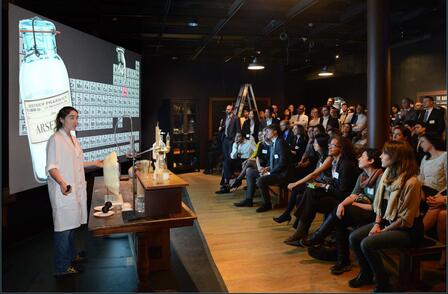http://www.amnh.org/explore/news-blogs/on-exhibit-posts/poison-what-killed-napoleon
Was Napoleon Bonaparte poisoned? This question has plagued historians since the defeated French emperor’s death on May 5, 1821, on the island of St. Helena in the South Atlantic, where he lived in exile for nearly six years. Since then, the debate has raged about the cause of Napoleon’s death, among several prominent and puzzling poisonings including the death of Cleopatra, highlighted in the new exhibition The Power of Poison.
Napoleon himself fueled suspicion, writing in his will a mere three weeks before his demise at age 51, “I die before my time, murdered by the English oligarchy and its assassin.” Chief among the theories for the exiled emperor’s death is arsenic poisoning—an idea reinforced by the remarkable condition of his body when it was exhumed in 1840 for reburial in Paris. Because it is also toxic to microorganisms, arsenic slows down the decomposition of human tissue, a phenomenon described as “arsenic mummification.” Subsequent 20th-century tests of preserved locks of Napoleon’s hair tested positive for arsenic.
But even if arsenic was the cause of death—which has not been proven with certainty—Napoleon’s charge of foul play may not be justified. A less dramatic but nonetheless plausible alternative is that Napoleon could have been exposed to the poison through the toxic fumes given off by wallpaper at Longwood, his prison home.
A sample had been secured by a visitor to the site in the 1820s and tucked into a family scrapbook. It surfaced in Norfolk, England, in the 1980s and, when tested by British scientists in the 1990s, was found to contain arsenic. The discovery was not entirely surprising given that arsenic-based pigments were widely used to create brilliant greens in the 19th century.
In a hot and damp room, the wallpaper would give off arsenical vapors—enough to account for what was found in his hair, though perhaps not enough to kill him.
Other evidence suggests that Napoleon’s exposure to arsenic was likely life-long. In 2008, an Italian team widened the inquiry by testing not only strands of Napoleon’s hair from four points in his life—including his boyhood, his exile, the day of his death, and the day after—but that of his son, Napoleon II, and his wife, Empress Josephine. All samples were found to have similarly high arsenic levels, roughly 100 times that of living people whose hair was included in the analysis for comparison. The team from Italy’s National Institute of Nuclear Physics concluded that the results suggest “chronic exposure…simply attributed to environmental factors, unfortunately no longer easily identifiable, or habits involving food and therapeutics.”
Arsenic was a common ingredient in a number of household products in the 19th century, according to The Poisoner’s Handbook, Deborah Blum’s compelling history of forensic medicine.
Besides containing arsenic to deter rats, wallpaper was also hung with arsenic-laced paste (a double-whammy that perhaps lends new meaning to Oscar Wilde’s rumored deathbed quip, “Either the wallpaper goes, or I do.”) The same arsenic-based pigments used in wallpaper also were used to color fabrics, artificial plants, candles, paper products, soap, and more. Arsenic was used in weed killers, fly paper, and as rat poison. In what were thought to be safe doses, arsenic was used in popular medicinal tonics like Dr. Fowler’s Solution, an arsenic-based cure-all for any number of ailments that was sold into the 1950s; “complexion wafers,” ingested to remove blemishes and produce translucent skin; and Salvarsan, widely prescribed for the treatment of syphilis, from which Napoleon was also said to suffer.
Even as arsenic was prevalent in healing potions, its potency as a poison was also well-established by the 19th century, especially as the soluble compound made by heating the heavy metal element with oxygen to form arsenic trioxide–the odorless and tasteless white arsenic. The latter was a notorious weapon of choice in both fact and fiction, as explored in The Power of Poison.
La canterella, thought to be a lethal mix of arsenic and cantharidin, was favored by the murderous Borgia family of Renaissance Italy. In France, where it was known as poudre de succession or “inheritance powder,” arsenic was implicated in almost 40 percent of all poison murders between 1835 and 1880, according to a study cited by Blum. In the U.S., another survey showed that of 31 indictments for poison murder in 12 counties in New York State for the decade 1879 to 1889, half involved white arsenic. From Agatha Christie in 4:50 from Paddington to Arthur Conan Doyle in A Study in Scarlet, crime writers have relied on its potency to drive dozens of plots.
As an instrument of murder, arsenic had advantages. Mixed in food or drink, it was difficult to taste. Especially administered over time in steady doses, the outward effects of arsenic poisoning—nausea, vomiting, diarrhea, convulsions, confusion, difficulty breathing, abdominal pain—mimic natural diseases, like influenza, cholera, or just an ulcer. Arsenic’s ubiquity into the 20th century meant that its presence in a cadaver was not necessarily considered proof of foul play.
Still, as forensic techniques improved over time, arsenic’s tendency to spread throughout the body eventually offered pathologists the edge. “A poison like arsenic, which hits some fundamental cellular process like the production of energy from sugars or other substances, affects everything,” says Mark Siddall, curator in the Division of Invertebrate Zoology who curated The Power of Poison. “This allows us to go back in time, because you can detect arsenic in hair samples that have been sitting around for a couple hundred years.”
In Napoleon’s case, arsenic was likely just one of many compounds taxing an already troubled system. In the course of treatments for a variety of symptoms—swollen legs, abdominal pain, jaundice, vomiting, weakness—Napoleon was subjected to a smorgasbord of other toxic substances. He was said to consume large amounts of a sweet apricot-based drink containing hydrocyanic acid. He had been given tarter emetic, an antimonal compound, by a Corsican doctor. (Like arsenic, antimony would also help explain the preserved state of his body at exhumation.) Two days before his death, his British doctors gave him a dose of calomel, or mercurous chloride, after which he collapsed into a stupor and never recovered. An autopsy carried out the next day revealed ulcerating stomach cancer.
In what is perhaps the most convincing hypothesis, published in the Journal of the Royal Society of Medicine in 2004, an international team of toxicologists and pathologists concluded that Napoleon’s death was a case of “medical misadventure,” and that the various drugs he was administered combined with the arsenic and a weak state of health to create a fatal imbalance and cardiac arrest. They added, “If the arsenic poisoning was intentional, it would still be homicide.”
And so the mystery continues.
See The Power of Poison, which is free for Members, now open at the Museum.




No comments:
Post a Comment